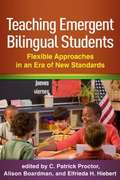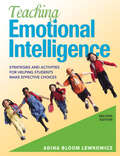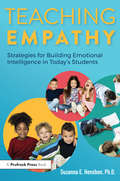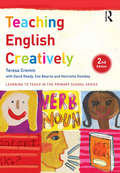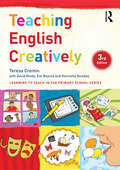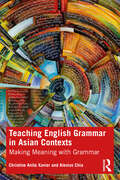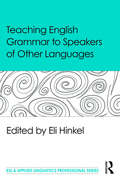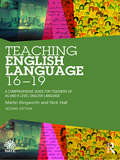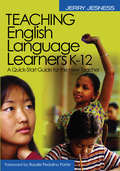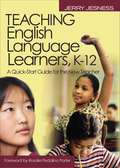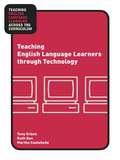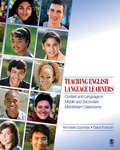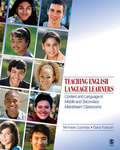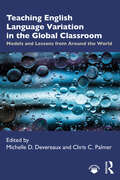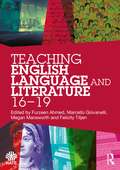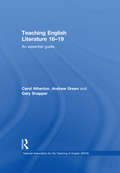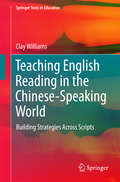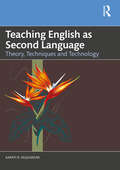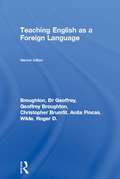- Table View
- List View
Teaching Emergent Bilingual Students: Flexible Approaches in an Era of New Standards
by Elfrieda H. Hiebert Alison Boardman C. Patrick ProctorRecent educational reform initiatives such as the Common Core State Standards (CCSS) largely fail to address the needs--or tap into the unique resources--of students who are developing literacy skills in both English and a home language. This book discusses ways to meet the challenges that current standards pose for teaching emergent bilingual students in grades K-8. Leading experts describe effective, standards-aligned instructional approaches and programs expressly developed to promote bilingual learners' academic vocabulary, comprehension, speaking, writing, and content learning. Innovative policy recommendations and professional development approaches are also presented.
Teaching Emotional Intelligence: Strategies and Activities for Helping Students Make Effective Choices
by Adina Bloom LewkowiczGive students the tools to make effective choices in and out of the classroom! This streamlined, teacher-friendly resource provides educators with fresh and engaging techniques to help learners increase self-awareness, manage emotions, build self-control, and develop positive relationships. The author provides a generous collection of fully developed lesson plans with role plays, ready-to-use reproducibles, and suggestions for adapting the activities to individual learning levels. This revised edition features: Expanded coverage of relevant research New lessons on topics such as bullying and violence prevention Lesson modifications for middle school students Guidelines for positive classroom management
Teaching Empathy: Strategies for Building Emotional Intelligence in Today's Students
by Suzanna E. HenshonAs classrooms become more diverse, it is increasingly important that students learn how to empathize with others who may come from very different backgrounds. Teaching Empathy:
Teaching English (Developing as a Reflective Secondary Teacher)
by Phil Rigby Lynne Warham Peter Woolnough Alyson Midgley Dr Carol EvansReflective practice is at the heart of effective teaching, and this book helps you develop into a reflective teacher of English. Everything you need is here: guidance on developing your analysis and self-evaluation skills, the knowledge of what you are trying to achieve and why, and examples of how experienced teachers deliver successful lessons. The book shows you how to plan lessons, how to make good use of resources and how to assess pupils' progress effectively. Each chapter contains points for reflection, which encourage you to break off from your reading and think about the challenging questions that you face as a new teacher. The book comes with access to a companion website, www.sagepub.co.uk/secondary , where you will find: - Videos of real lessons so you can see the skills discussed in the text in action - Links to a range of sites that provide useful additional support - Extra planning and resource materials. If you are training to teach English this book will help you to improve your classroom performance, by providing you with practical advice, but also by helping you to think in depth about the key issues. It also provides examples of the research evidence that is needed in academic work at Masters level, essential for anyone undertaking an M-level PGCE.
Teaching English Creatively (Learning to Teach in the Primary School Series)
by Teresa CreminWhat does it mean to teach English creatively to primary school children? Teaching English Creatively encourages and enables teachers to adopt a more creative approach to the teaching of English in the primary school. Fully updated to reflect the changing UK curricula, the second edition of this popular text explores research-informed practices and offers new ideas to develop imaginatively engaged readers, writers, speakers and listeners. Underpinned by theory and research, and illustrated throughout with examples of children's work, it examines the core elements of creative practice and how to explore powerful literary, non-fiction, visual and digital texts creatively. Key themes addressed include: Developing creativity in and through talk and drama Creatively engaging readers and writers Teaching grammar and comprehension imaginatively and in context Profiling meaning and purpose, autonomy, collaboration and play Planning, reviewing and celebrating literacy learning Ensuring the creative involvement of the teacher Inspiring and accessible, Teaching English Creatively puts contemporary and cutting-edge practice at the forefront and includes a wealth of innovative ideas to enrich English teaching. Written by an experienced author with extensive experience of initial teacher education and English teaching in the primary school, it's an invaluable resource for any teacher who wishes to embed creative approaches to teaching in their classroom.
Teaching English Creatively (Learning to Teach in the Primary School Series)
by Teresa CreminWhat does it mean to teach English creatively to primary school children? Teaching English Creatively encourages and enables teachers to adopt a more creative approach to the teaching of English in the primary school. Fully updated to reflect the changing UK curricula, the third edition of this popular text explores research-informed practice and offers new ideas to imaginatively engage readers, writers, speakers and listeners. Underpinned by up-to-date theory and research and illustrated throughout with more examples of children’s work, it examines the core elements of creative practice and how to explore powerful literary, non-fiction, visual and digital texts creatively. Key themes addressed include: • Developing creativity in and through talk and drama • Creatively engaging readers and writers • Teaching grammar and comprehension imaginatively and in context • Profiling meaning and purpose, autonomy, collaboration and play • Planning, reviewing and celebrating literacy learning • Ensuring the creative involvement of the teacher Inspiring, accessible and connected to current challenges and new priorities in education, Teaching English Creatively puts contemporary and cutting-edge practice at the forefront and includes a wealth of innovative ideas to enrich English teaching. Written by an experienced author with extensive experience of initial teacher education and English teaching in the primary school, it is an invaluable resource for any teacher who wishes to embed creative approaches to teaching in their classroom.
Teaching English Grammar in Asian Contexts: Making Meaning with Grammar
by Christine Xavier Alexius ChiaThis book guides teachers, teacher educators and pre-service student teachers on using grammar as a pedagogical tool for meaning making, linking grammar as a meaning-making resource to literacy development. When grammar is meaningfully linked to literacy skills such as reading and writing, there is contextualised teaching of grammar.The authors thoroughly explore key concepts in grammar, including grammar as structure and grammar as choice. They illuminate these concepts by analysing a range of authentic texts from Asian contexts, showing how specific grammar features are purposefully used to convey meaning. Examples and illustrations of teaching ideas and materials focusing on contextualised teaching of grammar, including lesson plans, activity outlines, worksheets and teaching strategies, are contributed by current teacher practitioners who have tried out these ideas in their language classes. These teacher practitioners also share their reflections on how these ideas have worked in their classes.As a result, this book is an indispensable resource for teachers, teacher educators, pre-service teachers of English as both a first language and a second or foreign language, as well as anyone who is interested in harnessing the power of grammar to enhance English language teaching and literacy development.
Teaching English Grammar to Speakers of Other Languages (ESL & Applied Linguistics Professional Series)
by Eli HinkelThis practical and research-based introduction to current and effective English grammar instruction gives pre-service and in-service teachers and teacher educators a strong foundation for teaching second language grammar and helps them develop their professional knowledge and skills. Written in a highly readable style for an international audience, it provides a thorough and rounded overview of the principles, strategies, techniques, and applications currently dominant in teaching L2 grammar in a range of instructional settings around the world. Chapter authors are world-class authorities in grammar and grammar teaching and learning. All chapters are based on theoretical frameworks and/or research foundations with a strong emphasis on practical applications and implications for classroom teaching, and highlight teaching methods, key concepts, and terminology associated with grammar instruction. Illuminating the options and choices in grammar teaching from a contemporary perspective, Teaching English Grammar to Speakers of Other Languages is ideal as key text for students in undergraduate and graduate MA-TESOL programs and as a resource for practicing ESL/EFL teachers, teacher educators, and teaching faculty.
Teaching English Language 16-19: A Comprehensive Guide for Teachers of AS and A Level English Language (National Association for the Teaching of English (NATE))
by Nick Hall Martin IllingworthThis unique guide to teaching English Language empowers teachers to lead a successful course that will encourage students to be independent and analytical linguists. Covering all areas of linguistic investigation across different exam board specifications and rooted in theoretical perspectives, this accessible text is underpinned by years of teaching experience and is full of practical ideas for classroom activities. Now in its second edition, this bestselling title has been fully updated to consider changes to English Language A level, including a new chapter on unseen texts and writing for the exams. Additional material includes a greater focus on accent and dialect, language acquisition, and language and the media, including discussions of ‘post-truth’ and ‘alternative facts’. The authors outline frameworks of linguistic analysis and provide clear guidance on how to approach different topics. Chapters are full of interesting extracts for textual analysis and ideas to give students a varied diet of written and spoken texts in different genres. Teaching English Language 16-19 will be invaluable reading for trainee teachers and practising teachers new to the teaching of English Language, as well as more experienced teachers wishing to refresh their knowledge and practice.
Teaching English Language Learners K-12: A Quick-Start Guide for the New Teacher
by Jerry JesnessThe author examines the immense demands faced by ELL educators and offers specific strategies to address these special challenges.
Teaching English Language Learners K12: A Quick-Start Guide for the New Teacher (1-off Ser.)
by Jerry JesnessBring the English language to life with this valuable new resource!Some say that learning a second language is like drinking water from a fire hose. But teaching it does not have to be like standing under Niagara Falls. This is the fundamental message of Jerry Jesness' new quick-start guide Teaching English Language Learners K-12. In our climate, ELL teachers face immense demands as educators because the ELL class is often the critical, transitional step into a student's entire education. The author provides specific strategies to address the special challenges for instructors. This valuable resource offers a terrific framework to nurture that motivating spark in English Language learners. For ELL educators, it's more than a job-it's a mission!Teaching English Language Learners K-12 includes: Customizing instructions to create developmentally and culturally appropriate lessons for all learners Comprehensive vocabulary checklists for common English words and concepts Practical methods for using the learner's native language and culture in the classroom Helpful strategies for teaching spoken English, reading, and writing Encouraging tips to become a better ELL teacherThis book delivers a concise array of teaching strategies, curriculum, and things ESL teachers need to know to become most confident in their work and most effective with their students.
Teaching English Language Learners in Career and Technical Education Programs
by Victor M. Hernández-Gantes William BlankExploring the unique challenges of vocational education, this book provides simple and straightforward advice on how to teach English Language Learners in today's Career and Technical Education programs. The authors' teaching framework and case studies draw from common settings in which career and technical educators find themselves working with ELLs—in the classroom, in the laboratory or workshop, and in work-based learning settings. By integrating CTE and academic instruction, and embedding career development activities across the curriculum, readers will gain a better understanding of the challenges of teaching occupationally-oriented content to a diverse group of learners in multiples settings.
Teaching English Language Learners through Technology
by Tony Erben Ruth Ban Martha CastañedaIn Teaching English Language Learners through Technology, the authors explore the use of computers/technology as a pedagogical tool to aid in the appropriate instruction of ELLs across all content areas. The special focus of this book is on the informed use of various technologies and software programs that can specifically aid ELLs. Strategies are also provided for varying levels of access--whether teachers teach in a one computer classroom, have access to multiple computers, or have the ability to go into a computer lab at their school. A fully annotated list of web and print resources completes the volume, making this a valuable reference to help teachers harness the power of computer-assisted technologies in meeting the challenges of including all learners in effective instruction.
Teaching English Language Learners: 43 Strategies for Successful K-8 Classrooms
by Michaela ColomboIdeal as a supplementary text for a variety of courses and as a guide for in-service teachers and for professional development settings, Teaching English Language Learners: 43 Strategies for Successful K–8 Classrooms provides teachers of all content areas with a broad, practical approach to teaching English language learners in the regular classroom setting.
Teaching English Language Learners: Content and Language in Middle and Secondary Mainstream Classrooms
by Michaela Colombo Dana FurbushTeaching English Language Learners: Content and Language in Middle and Secondary Mainstream Classrooms provides a reader-friendly guide to implementing and assessing high-level, content-area instruction for English Language Learners. Beginning with an overview of second language acquisition and the cultural variables that impact teaching and learning, authors Michaela Colombo and Dana Furbush go on to detail planning strategies, units and lessons. Practical in nature, this text focuses on the areas where it is often most difficult to make content comprehensible and build academic language skills: middle and secondary math, English language arts, history, and science. Teaching English Language Learners will provide pre- and in-service teachers with a foundational understanding of how to purposefully structure, build, and present effective lessons for English language learners in mainstream, content-area courses.
Teaching English Language Variation in the Global Classroom: Models And Lessons From Around The World
by Michelle D. Devereaux Chris C. PalmerTeaching English Language Variation in the Global Classroom offers researchers and teachers methods for instructing students on the diversity of the English language on a global scale. A complement to Devereaux and Palmer’s Teaching Language Variation in the Classroom, this collection provides real-world, classroom-tested strategies for teaching English language variation in a variety of contexts and countries, and with a variety of language learners. Each chapter balances theory with discussions of curriculum and lesson-planning to address how to effectively teach in global classrooms with approaches based on English language variation. With lessons and examples from five continents, the volume covers recent debates on many pedagogical topics, including standardization, stereotyping, code-switching, translanguaging, translation, identity, ideology, empathy, and post-colonial and critical theoretical approaches. The array of pedagogical strategies, accessible linguistic research, clear methods, and resources provided makes it an essential volume for pre-service and in-service teachers, graduate students, and scholars in courses on TESOL, EFL, World/Global Englishes, English as a Medium of Instruction, and Applied Linguistics.
Teaching English Language and Literature 16-19 (National Association for the Teaching of English (NATE))
by Furzeen AhmedThis book offers both a scholarly and practical overview of an integrated language and literature approach in the 16-19 English classroom. Providing a comprehensive overview of the identity of the subject, it outlines the pedagogical benefits of studying a unified English at post-16 and provides case studies of innovative classroom practice across a range of topics and text types. Including contributions from practising teachers and higher education practitioners with extensive experience of the post-16 classroom and drawing on a range of literature, this book covers the teaching of topics such as: Mind style in contemporary fiction Comparative poetry analysis Insights from linguistic cohesion Criticality through creative response Written to complement the two other Teaching English 16–19 titles in the NATE series, Teaching English Language and Literature 16–19 is the ideal companion for all practising A-level English teachers, of all levels of experience.
Teaching English Learners in Inclusive Classrooms
by Elda DuránTeachers and teacher trainers will find this clear, well-written text to be an invaluable resource in addressing the needs of myriad and unique students, especially those with disabilities.
Teaching English Literature 16-19: An essential guide (National Association for the Teaching of English (NATE))
by Andrew Green Carol Atherton Gary SnapperTeaching English Literature 16 – 19 is an essential new resource that is suitable for use both as an introductory guide for those new to teaching literature and also as an aid to reflection and renewal for more experienced teachers. Using the central philosophy that students will learn best when actively engaged in discussion and encouraged to apply what they have learnt independently, this highly practical new text contains: discussion of the principles behind the teaching of literature at this level; guidelines on course planning, pedagogy, content and subject knowledge; advice on teaching literature taking into account a range of broader contexts, such as literary criticism, literary theory, performance, publishing, creative writing and journalism; examples of practical activities, worksheets and suggestions for texts; guides to available resources. Aimed at English teachers, teacher trainees, teacher trainers and advisors, this resource is packed full of new and workable ideas for teaching all English literature courses.
Teaching English Reading in the Chinese-Speaking World
by Clay WilliamsThis book investigates inherent, structural differences in the Chinese and English writing systems which predispose learners from childhood to develop specific literacy-learning strategies, which can impair later efforts at learning foreign language literacy if the foreign language script varies significantly from the native language script. It compares educational practices and philosophies in Chinese and English-speaking classrooms, and examines the psychological underpinnings of these literacy learning strategies. This book presents psychometric testing of adult reading strategy defaults and examines case study data, revealing that Chinese students are susceptible to misapplying Chinese character-level processing strategies to English word identification tasks, which decreases reading efficiency, and ultimately can lead to learning failure. Finally, a new educational framework is proposed for teaching beginning language-specific word identification and literacy-learning skills to learners whose first language script varies significantly from that of the target language.
Teaching English Through ELA, Mathematics, Science, and Social Studies: A Content-Based Language Teaching Approach
by Long PengAccessible and hands-on, this textbook provides a comprehensive introduction to teaching language through content, an approach known as Content-Based Language Teaching (CBLT). A content-based, language-focused approach to teaching in the disciplines is essential to serving the language and disciplinary needs of English learners (ELs) in the classroom. Guided by learning standards and informed by research, this book demonstrates how content materials in the English Language Arts (ELA), Mathematics, Science, and Social Studies can be harnessed to develop the English language proficiency of ELs as well as advance their disciplinary knowledge and skills. Using content materials in ELA, Mathematics, Science, and Social Studies as a starting point, this textbook illustrates how to teach English as an additional language effectively by integrating language instruction with disciplinary teaching. It showcases numerous learning and instructional activities, complete with targeted language exemplified in sentential and discourse contexts, direct instruction, teacher modeling, guided and individual practices, and assessments, which are further backed up by detailed discussions of their goals, rationales, and implementation. This textbook also features a discussion of differentiation to address the varied needs of students. To further assist readers in determining how to incorporate language instruction, Peng identifies extensive possibilities for language teaching that are based on the same content materials and beyond those targeted by sample learning activities. Each chapter ends with three types of exercises—multiple-choice questions, open-ended discussion questions, and problems of application—to bolster understanding, promote reflection, and encourage application. Complementing the book are additional online resources, including ready-to-use PowerPoints, which are available on the book’s webpage at Routledge.com/9780367521134. Covering key issues such as characteristics of effective language instruction, differentiation, and the challenges associated with CBLT, this is an essential text in TESOL methods and content-area language teaching, as well as an invaluable resource for pre-service and in-service ESL/EFL teachers and content-area teachers who are interested in furthering their students’ language and literacy development.
Teaching English and Maths in FE: What works for vocational learners?
by David AllanThis book is a guide for all teachers in the FE and Skills Sector, regardless of their discipline. It explores how FE teachers can address the mathematics and English needs of all learners, to redress the skills gap that is a current focus. The text explores what works in the sector, examining the barriers to learning and how all learners can be included. It takes a focused look at what works for the vocational learners who have not succeeded in a school setting, and helps tackle the problem of low motivation in learners. The text goes beyond simply providing strategies to follow and includes background theory and detailed case studies to enhance your understanding of different approaches.
Teaching English and Maths in FE: What works for vocational learners?
by David AllanThis book is a guide for all teachers in the FE and Skills Sector, regardless of their discipline. It explores how FE teachers can address the mathematics and English needs of all learners, to redress the skills gap that is a current focus. The text explores what works in the sector, examining the barriers to learning and how all learners can be included. It takes a focused look at what works for the vocational learners who have not succeeded in a school setting, and helps tackle the problem of low motivation in learners. The text goes beyond simply providing strategies to follow and includes background theory and detailed case studies to enhance your understanding of different approaches.
Teaching English as Second Language: Theory, Techniques and Technology
by Aarati R MujumdarThis multidisciplinary volume is a systematic, well-researched resource to help understand the methods and techniques of teaching English as a second language. It integrates theory with praxis, drawing on the Cognitivist–Social interactionist theory and Constructivist approaches adopted in an English classroom. It provides insights into recent trends in teaching, given the changed teaching–learning scenario in education, while simultaneously aiding in the development of the 4IR skills much needed in the 21st century.Written in an easy-to-understand language, the book expounds on various language skills and their application in real-world classrooms. These classroom-tested techniques can be used by teachers by modifying the context in which they are used. The tasks help develop critical-thinking and problem-solving abilities in learners. The techniques and practices elucidated in the book are designed to be accessible to a global readership.This book will be useful to students, pre-service teachers, and researchers, who are new to the teaching of English Language. It will also be an essential companion to practicing in-service teachers and Teacher Trainers to further sharpen their concepts and skills.
Teaching English as a Foreign Language
by Geoffrey Broughton Christopher Brumfit Anita Pincas Roger D. Wilde Dr Geoffrey BroughtonFor the many categories of EFL teachers throughout the world, this book examines the main principles which concern them. By drawing upon their experience the authors have indicated a modern and practical approach.
